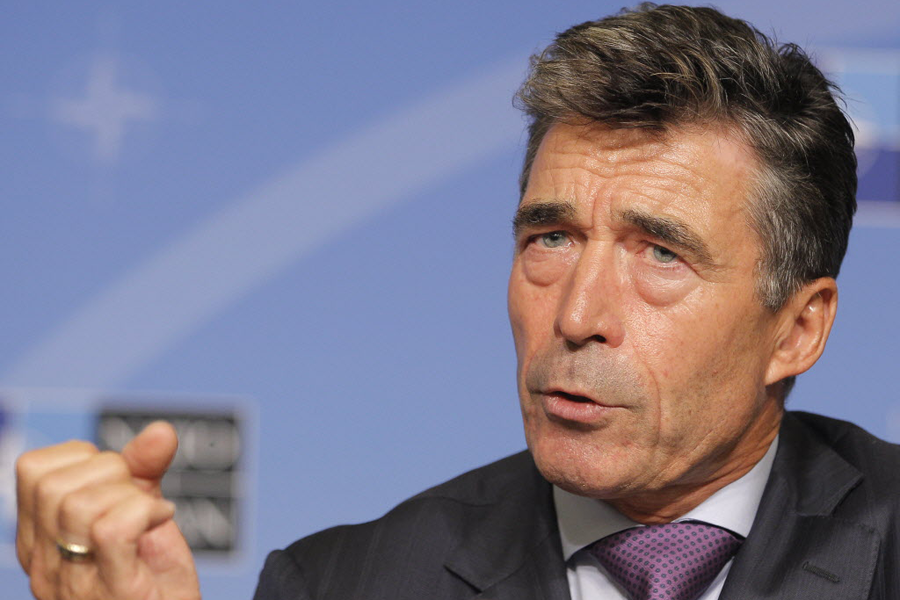How NATO is navigating Syria (and other issues for the evolving Alliance)
Loading...
| United Nations, N.Y.
One of the advantages for NATO Secretary-General Anders Fogh Rasmussen in attending the United Nations General Assembly meeting this week is that it’s not his show.
That means the former Danish prime minister at the helm of the 28-nation Atlantic Alliance has a little extra unprogrammed time – for a morning run or two in Central Park or to meet with reporters to extend to the US public his message of NATO’s transition from a cold-war footing to a 21st-century security alliance.
Mr. Rasmussen, whose five-year term ends next summer, sat down in New York with the Monitor to discuss Syria, Afghanistan, and why “smart defense” will be a growing feature of cash-strapped NATO members’ security future.
Syria: Steps to protect Turkey from civil war spillover, but no additional role
At Turkey’s request, NATO deployed batteries of Patriot missiles along the Alliance member’s border with Syria, and provocative incidents between the two unfriendly countries largely ceased. “We do believe [deploying the Patriots] has a deterrent effect, so that potential adversaries don’t even think about attacking Turkey,” Rasmussen says.
But don’t look for NATO involvement in implementation of the plan to eliminate Syria’s chemical weapons. The Aug. 21 chemical weapons attack outside Damascus “needs a firm response from the international community here and now,” he says, before adding: “I don’t foresee any further role for NATO.”
Russia has indicated it could be open to providing a military component to help with security for the chemical weapons inspectors and experts who would be implementing the plan in a war zone. But Russia, which regards NATO as having overstepped its bounds by intervening in Libya in 2011, would almost certainly be skeptical of Alliance participation in Syria.
But Rasmussen says “individual allies” (NATO members) “have capabilities that would be useful to the weapons-elimination program.” As a result, he envisions that “if requested, NATO could play a coordinating role in such [Allied] efforts.”
On Afghanistan: A post-2014 role for NATO, waiting for a ‘go’ from Karzai
Rasmussen is upbeat on Afghanistan, noting that Afghan security forces now lead “almost all security operations” and have impressed NATO commanders with how they are performing. “We have seen them deal with recent security incidents in quite a capable manner,” he says.
But the Afghan Army’s officer corps in particular will need additional training in “command and control” capabilities past the conclusion of NATO’s Afghanistan mission in December 2014, Rasmussen says. “We need to focus on the leadership level,” he adds.
And while he’s confident Alliance members are prepared to contribute to a post-2014 role, he also cautions that Afghanistan has to take certain steps to make a new NATO mission possible.
“Before we can do that, we need to know whether we will be invited – and what will be the legal framework” for a NATO presence, he says. “I have on several occasions told President [Hamid] Karzai that it is a prerequisite for our continued presence in Afghanistan that we are invited, and that we have a firm legal framework, a status-of-forces agreement” or SOFA.
Mr. Karzai’s first priority is to see if he can negotiate an agreement with the United States, which would require its own SOFA – including immunity from Afghan justice for US military personnel – before agreeing to a training and counterterrorism presence in post-2014 Afghanistan.
Time is running short – Afghanistan is to hold pivotal national elections in April – but Rasmussen predicts the hurdles to a continuing Alliance role will be overcome. Karzai “understands that we can’t deploy unless we have a very clear legal framework,” he says. “I’m confident we’ll reach an agreement.”
On NATO in the 21st century: A new strategic concept of three ‘core tasks’
First, “territorial defense.” Deploying Patriot missiles to Turkey is an example.
Second, “crisis management.” The Libya intervention showcased the “new NATO,” Rasmussen says, with “a very short, targeted operation to implement a UN resolution based on the ‘responsibility to protect,’ ” a nascent international humanitarian intervention doctrine.
Third, “cooperative security,” a “partnership concept” that expands the reach and heft of Alliance activity outside the NATO area by bringing in outside participants to NATO missions. “We realize that if we are to accomplish our security mission in the modern world we need strong partnerships,” Rasmussen says: “for political dialogue, but also for concrete operational contributions.”
In Afghanistan, for example, 22 non-NATO countries are present on the ground alongside the 28 NATO members, creating a partnership of 50 countries.
“It gives us strength, but it also gives us broad political legitimacy,” he says.
On NATO’s reform under his tenure: a tauter, smarter Alliance
For weary American taxpayers tempted to dismiss an international institution like NATO as a bloated cold-war relic, Rasmussen has a message: “We have cut fat and built up muscles.”
As part of a major streamlining effort, NATO has cut its administrative workforce by a third, and reduced the number of divisional headquarters from 11 to 7 – even as the Alliance has taken on new missions reflecting the challenges of today’s world.
Noting that “Today we can no longer provide adequate security by lining up tanks along our borders,” Rasmussen says NATO has had to expand its concept of what “providing security” means to include fighting terrorism in Afghanistan, tackling piracy off the coast of Somalia, and addressing the growing global threat of cyberattacks.
To do more with less, NATO under Rasmussen is shifting to what he likes to call “smart defense:” taking the cooperative spirit underpinning the Alliance and extending it to the acquisition and operation of new military capabilities.
By more “pooling of resources,” he says, increasingly prohibitive hardware, personnel, and training costs can be shared, and “we will be able to maintain our ability to work and operate together. That’s also part of NATO’s future.”






